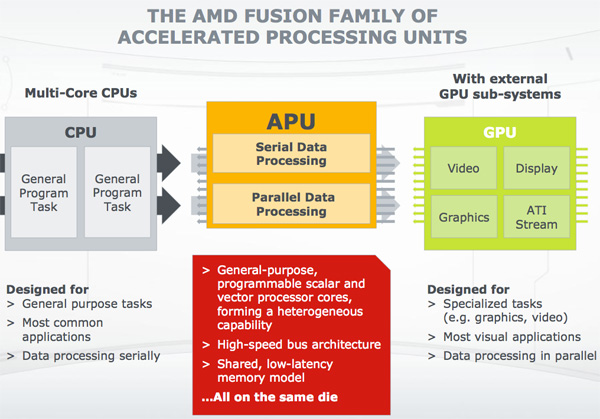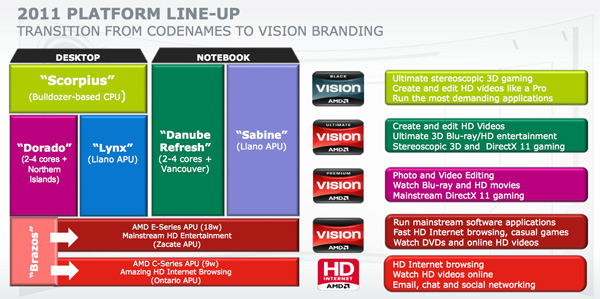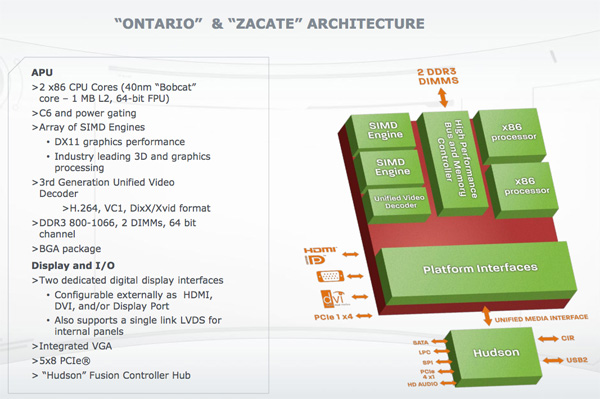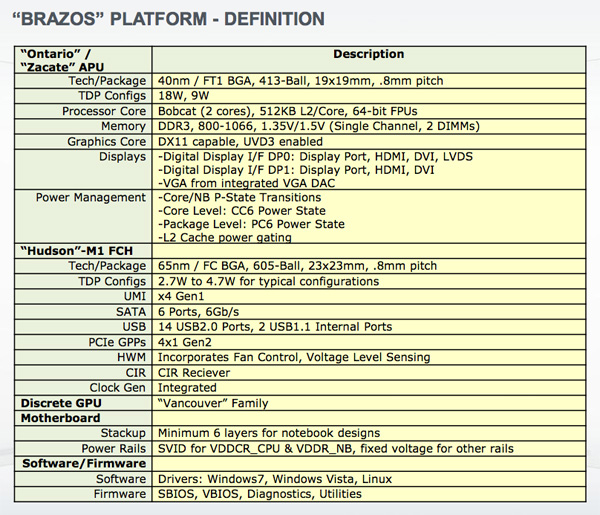Previewing AMD's Brazos, Part 1: More Details on Zacate/Ontario and Fusion
by Anand Lal Shimpi on November 9, 2010 1:09 AM ESTMeet the Brazos
The platform is called Brazos. Brazos encompasses two chips: a Zacate or Ontario APU (Accelerated Processing Unit) and the Hudson Fusion Controller Hub (FCH). This is the whole reason AMD bought ATI, Zacate and Ontario are its first CPU-GPU hybrids.
While AMD is primarily targeting the netbook/ultraportable and notebook markets with Ontario and Zacate (respectively), we’ll also see nettops/desktops and mini-ITX motherboards based on Brazos. This may be the first time we see real competition to NVIDIA’s ION platform.

AMD's Zacate APU, 19mm x 19mm package, 413 balls, 75mm^2 die
Both APUs are built from the same die. Zacate and Ontario are physically identical, they just run at different clock speeds. The 40nm die is manufactured at TSMC and measures 75mm^2. The chip is very cheap to package as well. The BGA package only has 413 balls. As one AMDer put it, these chips are designed to be stamped out as quickly and as cheaply as possible.
Both are available in single and dual core versions, although the single core variant is just a dual-core chip with one core disabled to hit various market segments. Core unlocking is apparently possible, but unexpected given the target for these platforms and the amount of effort OEMs would have to go to in order to enable it.
The CPU cores are based on AMD’s first truly low power client architecture, codenamed Bobcat. We’ve discussed Bobcat in great length already, but at a high level it looks a lot like an out-of-order Atom processor without Hyper Threading. The fundamental architecture advantage should give Bobcat the performance advantage over Atom, at least at identical clock speeds.
The GPU is based on AMD’s 5000 series architecture (Evergreen) and features 80 shader cores and AMD’s new UVD3 decode engine.
The SKUs
At launch you’ll see four SKUs, the combinations and specs are listed below:
| AMD Brazos Lineup | ||||||||
| APU Model | Number of Bobcat Cores | CPU Clock Speed | GPU | Number of GPU Cores | GPU Clock Speed | TDP | ||
| AMD E-350 | 2 | 1.6GHz | Radeon HD 6310 | 80 | 500MHz | 18W | ||
| AMD E-240 | 1 | 1.5GHz | Radeon HD 6310 | 80 | 500MHz | 18W | ||
| AMD C-50 | 2 | 1.0GHz | Radeon HD 6250 | 80 | 280MHz | 9W | ||
| AMD C-30 | 1 | 1.2GHz | Radeon HD 6250 | 80 | 280MHz | 9W | ||
Zacate takes the top two SKUs, while Ontario makes up the bottom two. The difference in TDP is entirely based on the clock speed of the CPU and GPU. And here is my concern. While a pair of Bobcats running at 1.6GHz are just awesome, drop the clock to 1.0GHz and I start getting concerned about performance. AMD didn’t let us test the C-50 but I’m curious to see what the margin of victory will be over Atom at that speed.
The GPU runs at 500MHz at the high end (Radeon HD 6310) and 280MHz at the low end (Radeon HD 6250). This paired with the single channel DDR3-800/1066 memory bus that has to be shared with the Bobcat cores means you should expect sub-5450 levels of performance out of these systems. Given their price point, that’s potentially not too bad. More enticing however is the fact that these APUs gain the benefit of the driver work AMD does on its discrete cards. Finally, game compatibility should be just as good on the low end as it is on the high end - assuming you meet the minimum specs for the title you’re running.
The lack of a brand for the CPU is a bit puzzling, but graphics are where it’s at these days.














106 Comments
View All Comments
miahshodan - Tuesday, November 9, 2010 - link
I meant HD4500 graphics, not 945asmoma - Tuesday, November 9, 2010 - link
First gen CULV does have lower power consumption than brazos and about the same as 2. gen CULV.http://media.bestofmicro.com/amd-fusion-power,1-6-...
http://images.anandtech.com/graphs/toshibat235d_08...
5,31(minutes/wh)*1,35 is 7(minutes/wh). But because only the cpu and chipset is taken into consideration, the actual minutes/wh is lower.
This does not make the brazos platform a bad product(like the yukon and congo platform(rubbish!)), but it won't be a product for high end(high quality) products like macbooks and vaio z.
asmoma - Tuesday, November 9, 2010 - link
"5,31(minutes/wh)*1,35 is 7(minutes/wh). But because only the cpu and chipset is taken into consideration, the actual minutes/wh is lower"Maybe even lower than 2. gen culv
jbhunt17 - Tuesday, November 9, 2010 - link
What game is that on the screen? Looks cool.LeftSide - Tuesday, November 9, 2010 - link
Anand,Will these new amd processors support ECC ram? I want to build a new low power Windows Home Server, and want to use ECC ram. Atom is too slow and doesn't support it.
Thanks!
ProDigit - Tuesday, November 9, 2010 - link
Darn, Homer Simpson's APU would not like it to be compared to a computer chip!So what do we call it, APU (A-Poo, APU with the u from 'under' or the U from 'unanimous')?
ProDigit - Tuesday, November 9, 2010 - link
In all honesty, those cpu's + GPU's are good enough for (heavy powerdrawing) netbooks, not notebooks or laptops, and especially not desktops!They may be good for HTPC's or small servers, but I see no unit strong enough to replace a C2Duo laptop (or desktop). (especially not at the price).
jabber - Wednesday, November 10, 2010 - link
Again this setup isnt for enthusiasts.Its not designed with you in mind.
Its designed for your mum and dad who are still hobbling along with their old P4 or Celeron machine they bought back in 2005.
Its designed for the knock about family PC that gets used mainly for Ebay, Messenger and Facebook and may allow the 13 year old daughter to play the Sims.
This will be plenty powerful enough for small low power boxes in the home.
Dark_Archonis - Tuesday, November 9, 2010 - link
Whether you know anyone who wants an iPad is irrelevant. Personal anecdotal observations are frankly irrelevant.It is a statistical fact that *since* the iPad went on sale, netbook sales have been declining harder. Acer in particular is suffering as its netbook sales over the last few months have been down BIG-TIME, and Acer is one of the big netbook OEMs.
Millions of iPads have already been sold, and Apple continues to sell them at a very high rate.
Yes Atom's lack of performance in some areas might have contributed. However it is ludicrous to completely deny the impact the iPad is having on netbook sales.
bloodterfly - Wednesday, November 10, 2010 - link
For someone who uses statistics as an argument, you seem highly ignorant of the fact correlation != causation.iPad goes up, net books go down doesn't prove anything.
Any number of myriad factors could've caused netbooks to stop selling.